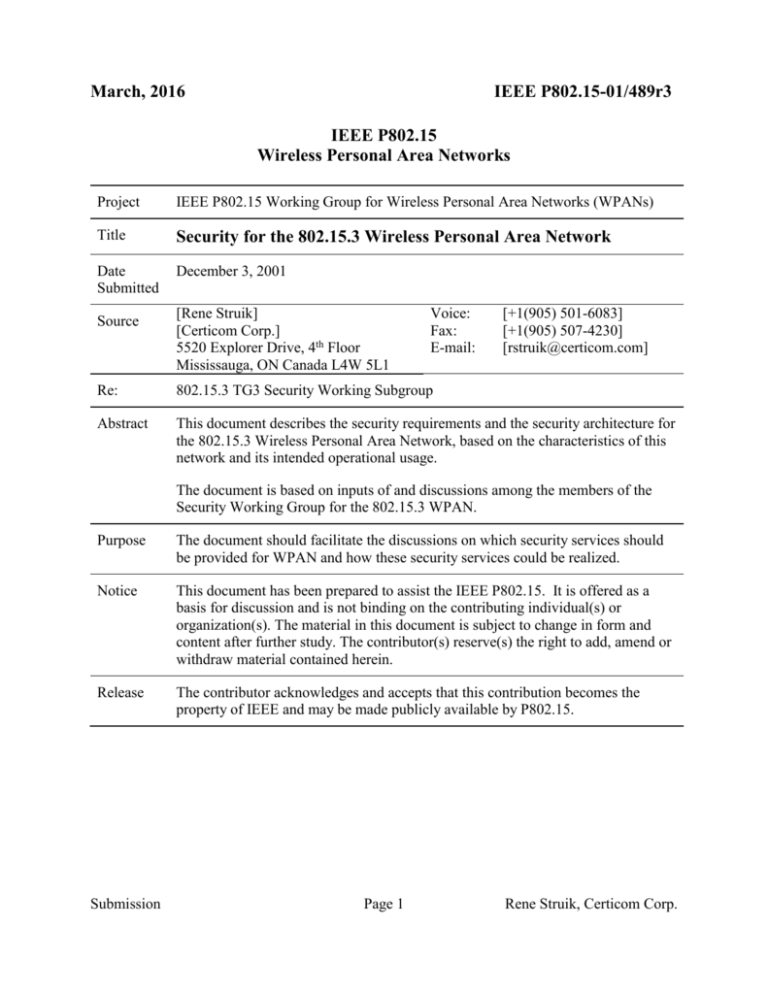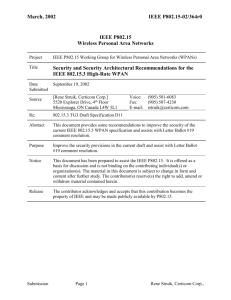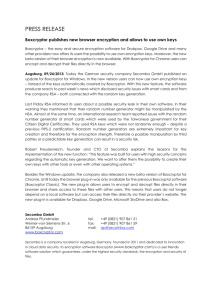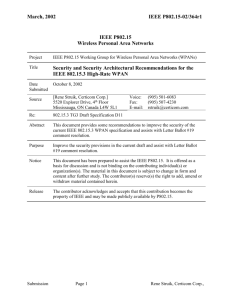Security for the 802.15.3 Wireless Personal Area Network - IEEE
advertisement

March, 2016 IEEE P802.15-01/489r3 IEEE P802.15 Wireless Personal Area Networks Project IEEE P802.15 Working Group for Wireless Personal Area Networks (WPANs) Title Security for the 802.15.3 Wireless Personal Area Network Date Submitted December 3, 2001 Source [Rene Struik] [Certicom Corp.] 5520 Explorer Drive, 4th Floor Mississauga, ON Canada L4W 5L1 Re: 802.15.3 TG3 Security Working Subgroup Abstract This document describes the security requirements and the security architecture for the 802.15.3 Wireless Personal Area Network, based on the characteristics of this network and its intended operational usage. Voice: Fax: E-mail: [+1(905) 501-6083] [+1(905) 507-4230] [rstruik@certicom.com] The document is based on inputs of and discussions among the members of the Security Working Group for the 802.15.3 WPAN. Purpose The document should facilitate the discussions on which security services should be provided for WPAN and how these security services could be realized. Notice This document has been prepared to assist the IEEE P802.15. It is offered as a basis for discussion and is not binding on the contributing individual(s) or organization(s). The material in this document is subject to change in form and content after further study. The contributor(s) reserve(s) the right to add, amend or withdraw material contained herein. Release The contributor acknowledges and accepts that this contribution becomes the property of IEEE and may be made publicly available by P802.15. Submission Page 1 Rene Struik, Certicom Corp. March, 2016 IEEE P802.15-01/489r3 (BEGIN) DISCUSSION TOPICS November 6, 2001 Outline: 1) Initial key set-up (public keys): a) Hierarchy with trusted party; b) No hierarchy, no trusted party (self-certified public keys, implied trust from higher layer). 2) Key establishment: a) Establishment of the key encryption key (KEK). b) Establishment of the data encryption key (DEK). i) Key control by either party (e.g., for encrypted large file, e.g., video stream). ii) Absence of key control. 3) Key updates (relative to a particular piconet): a) Changes to the group structure: i) Introduction of a new group member; ii) Exclusion of a current group member. b) Changes to the PNC: we don’t care (no security functionality). c) Changes to the Security Manager: i) Effect: re-do everything; ii) Public keys re-established by discovery process or certificate list recovery (use distributed storage?). 4) Trust chains (personalization of devices): a) Device certificate by manufacturer; b) User/owner certificate; c) Attribute certificate for either user or device (if applicable); 5) Security services: a) Specific combinations of entity authentication, data integrity, confidentiality (including ‘no security’). 6) Group model: a) Group key: all devices in a piconet have access to all communications. b) Subgroup allowance: subgroup G of devices that have access to a key: pair (G, KeyG). The group G can be represented in compressed format, provided a mapping between groups and device Ids is maintained. 7) Access control list (ACL): a) Public key of device A is only accepted if it is authentic and if the device Id is in the access control list. i) ACL bottom up (explicit mentioning of devices that are considered ‘friendly’). Set-up after initialization, e.g., of home entertainment network. ii) ACL forbidden list (implicit assumption of ‘friendliness’). Submission Page 2 Rene Struik, Certicom Corp. March, 2016 IEEE P802.15-01/489r3 Privacy and Security 1. System overview In this section, we recapitulate the security-relevant characteristics of the WPAN technology and state some restrictions this wireless technology imposes on the security that could potentially be provided within the wireless PAN context. 1.1 Characteristics of the 802.15.3 WPAN The 802.15.3 Wireless Personal Area Network exhibits the following security-relevant characteristics: 1. Communications technology. Data and voice communications is based on radio transmissions operating at 2.4 GHz between static or moving objects that are, typically, at most 10 meters apart. Data transmission rates are above 20 Mbps. 2. Devices. The network is intended for short-range communications between consumer devices including Computers, PDAs, handheld PCs, printers; Digital imaging systems, microphones, speakers, and headsets; Personal and professional video streams (e.g., set-top box output to TV, security camera); Barcode readers, sensors, displays, pagers, mobile and PCS phones. Each device has a unique Id (the IEEE device address). 3. Personal Area Network (piconet). Communication takes place between a collection of at most 255 devices (nodes) that operate on close distance from one another, in a so-called piconet. Communication can be in one of two forms: peer-to-peer and broadcast. One device, the so-called piconet controller (PNC), has a special role: it takes care of message control and regulates admission of devices to the piconet. Typically, the PNC is a one of the more resourceful devices in the network. The PNC need not be fixed in space and time: PNCs can wander around and be assigned dynamically. Similarly, nodes may connect and disconnect in an ad-hoc fashion. 4. Interaction with the outside world. Communication of data between a piconet and other networks, such as wireless LANs and fixed LANs (e.g., IEEE 802.3), takes place via a so-called portal, which communicates MAC service data units back and forth. In the sequel, we will restrict ourselves to communication behaviour between WPAN-enabled devices. Communications with the outside world should be addressed elsewhere and is considered to be out of scope. 1.2 Security constraints imposed by the 802.15.3 WPAN The 802.15.3 WPAN imposes the following security constraints: 1. Untrusted devices. Devices are low-cost consumer electronics devices. Secure and authentic storage of keying material in such a device can therefore not be assumed a priori, nor the presence of a high quality random number generator. 2. Devices with limited capabilities. Devices are low-cost consumer electronic devices. Thus, one has to take into account limitations on computing power, memory constraints, and power drain. This might limit the choice of cryptographic algorithms and protocols, esp. given the relatively high data rate required. 3. Short-range communications only. The communications technology only allows communications between devices that are relatively close to each other. Thus, one cannot rely on on-line centralized key management, since the trusted party might be out of range. Off-line involvement of a centralized Submission Page 3 Rene Struik, Certicom Corp. March, 2016 IEEE P802.15-01/489r3 trusted party, however, could still be realized. (This situation is quite similar to that experienced with typical CA services in use at present, where the validity of certificates is checked off-line rather than online, to lower the communication overhead). 4. Short-lived relationships. Devices communicate in an ad-hoc fashion and might never have met before. Thus, initial establishment of trust between these devices needs to be addressed. 2. Security requirements In this section, we introduce the security requirements for the 802.15.3 Wireless Personal Area Network technology. The security requirements are based upon a discussion of potential security services that might be required and a critical assessment of limitations of the wireless PAN technology. 2.1 Potential security services The security services that need to be provided might include a combination of the following: 1. Mutual entity authentication. Evidence to communicating devices regarding the identity of their communicating parties. 2. Data Integrity. Assurances that communicated data and control strings have not been altered in transit. 3. Confidentiality. Guarantee that communicated data remains private to the parties that knowingly partake in communications. 4. Non-repudiation. Binding of a communicating device to its commitments and/or actions, such that these cannot be denied later on. 5. Anonymity. Non-disclosure of the identity of communicating parties to any third party. 6. Availability. Assurances as to the continuity of service delivery (here: security services). The actual security services that are required (or desirable) depend on the actual application at hand. A short discussion exemplifying the potential need for a (combination of) security service(s) follows. Confidentiality of data is required to prevent exposure of potentially sensitive data, such as Pay TV signals and personal data synchronized between a PDA and another device trusted by the PDA user. Integrity is needed to ensure that data is received accurately and completely, such as personal data and video streams communicated by a security camera. Source authentication is required to assure the receiving device as to the true identity of the sending device, such as a PDA or, again, a security camera. Destination authentication is required to assure the sending device as to the true identity of the recipient, such as the computing devices a PDA synchronizes to and TV monitor and speakers with copy protection circuitry aboard a set-top box or other home entertainment box communicates to. Non-repudiation is required in settings where denial of previous commitments should be prevented, such as ordering Videoon-Demand services, software upgrades of digital TV capabilities, and downloading of music. Anonymity might be required to prevent linkage of data trails to individuals, such as to respect privacy of individuals or simply to comply with privacy laws. Availability is desirable to ensure quality of service. Some of the security services cannot be met in the 802.15.3 WPAN setting or are more appropriately realized elsewhere. Availability assurances cannot be given, since the radio signal transmissions in a piconet can easily be overruled by powerful jamming equipment. The requirement for anonymity might conflict with the need for entity authentication in networks where devices might never have met before. Non-repudiation might be more appropriately realized outside the MAC (Medium Access Control) and PHY (Physical) layer, e.g., at the application level. The same remark might apply to some of the other security services, e.g., confidentiality and data integrity. All security services ultimately depend on the availability of some secret piece of information at every user device and, hence, require a trusted component that allows the secure processing and storage hereof. Moreover, many cryptographic Submission Page 4 Rene Struik, Certicom Corp. March, 2016 IEEE P802.15-01/489r3 operations require a high quality source of randomness, to prevent attacks that exploit the predictability of part of the protocol messages to derive information on secret keys. The availability of a trusted processing and storage facility and some source of randomness might, however, not be a given in a lowcost consumer device. Without this, no cryptographic security can be provided. 2.2 Actual security services The security services that are to be provided include a combination of the following: 1. Mutual entity authentication. Evidence to communicating devices regarding the identity of their communicating parties. 2. Data Integrity. Assurances that communicated data and control strings have not been altered in transit. 3. Confidentiality. Guarantee that communicated data remains private to the parties that knowingly partake in communications. A short discussion follows. Communication within a piconet takes place between semi-autonomous devices that may connect to the piconet in an ad-hoc fashion and might never have met before. Regulation of admission of these devices requires evidence as to the true identity of the devices that comprise the piconet. Message control requires monitoring of the devices that are alive within the piconet. In both cases, entity authentication is required. Confidentiality is required to prevent exposure of sensitive data to unauthorized parties, in particular to those parties that do not take part in the piconet. Data integrity might be required to ensure that data is received accurately and completely by its intended recipients. With these security services in place, the asurances that one has come to expect of wired networks – i.e., confidentiality, integrity, and authentication – carry over to (inter)networking between WPAN-enabled devices. 2.3 Actual security requirements The security requirements include a combination of the following: 1. Joining of authenticated parties only. At any given moment of time, admission of a device to a piconet (association) must be based upon evidence regarding its true identity and proof that the device itself corroborated this evidence. 2. Communication between identified parties only. At any given moment of time, access to information shared between members of a group must be restricted to precisely these group members. As such, this includes access to integrity information. Note that both security requirements can be realized by cryptographic means, via entity authentication techniques and data encryption and data integrity mechanisms. Remark We have deliberately been vague about what we mean by a ‘group’ of piconet devices. Conceptually, it refers to any subset of the devices that constitute the piconet and, hence, includes peer-to-peer (end-toend) communication, multicasting, and broadcasting. In practical scenarios, we will be foremost interested in the broadcast scenario. Submission Page 5 Rene Struik, Certicom Corp. March, 2016 IEEE P802.15-01/489r3 3. Security architectural overview In this section, we describe the security architecture that implements the security services and the security requirements of the 802.15.3 Wireless Personal Area Network. Moreover, we clearly state the security assumptions that underly our approach. Finally, we mention some limitations of our approach. 3.1 Security assumptions The security provided by the security architecture depends on the security of the public and symmetric keys it operates upon and on the security provided by the cryptographic primitives involved. Thus, trust in the security of the architecture ultimately reduces to trust in the secure initialization and installation of keying material and to trust in the secure processing and storage of keying material. 3.1.1 Trusted device We assume each entity to have access to a privately held trusted device, trust being relative to the environment in which the device is to be operated. The trusted device is the exclusive source the entity calls upon for the processing of cryptographic functions and the storage of plain keying material. The trusted device is assumed to provide for sufficient secure (and/or authentic) storage and for sufficient secure1 processing capabilities. Here, one distinguishes between the following types of protected memory: secure memory (no read access), authentic memory (no write access), and secure and authentic memory (no read/write access). 3.1.2 Random Number Generator (RNG) We assume each entity to have access to a privately held secure (pseudo) random number generator. This RNG is the exclusive source the entity calls upon for the generation of random values and/or strings. Furthermore, we assume the outputs of each pair of random number generators to be statistically uncorrelated. 3.1.3 Authentic public keys We assume the external presence of a distinguished party T who vouches for the authenticity of the binding between an entity A and its public encryption key PA. (This party is called the External Trusted Party.) The actual implementation of this binding, and a verification mechanism therefore, depends on context. We discuss two suitable methods. 1. Public key certificates. The external trusted party T provides his signature over A’s public key and A’s identifying information and includes these data in a public key certificate. Generation of the public key certificate requires interaction between Party A and the external trusted party, to provide evidence as to A’s true identity and as to its possession of the corresponding private key. Verification of the authenticity of A’s public key requires the signature of Party T, as contained in the public key certificate, to be verified. Thus, it only necessitates the verifying party to have access to an authentic copy of the (public) signature verification string of Party T, rather than to the public keys of all its potential communicating parties. 2. Implicit certificates. This provides an alternative for public key certificates. The main idea here is that it is not necessary to store public keys as such; storage of related data instead, plus an efficient procedure for reconstructing public keys from these, suffices. With implicitly certified public keys, the public key is reconstructed based upon the identity of the device the public key is associated with 1 Without leakage of keying material due to, e.g., side channel attacks. Submission Page 6 Rene Struik, Certicom Corp. March, 2016 IEEE P802.15-01/489r3 and the previously mentioned related data. In addition, evidence regarding the authenticity of the reconstructed public key string is provided. As with public key certificates, the generation of implicit certificates requires interaction with the external trusted party. We assume an authentic copy of T’s public signature verification string to be stored in a device, at the time of manufacturing or at personalization of the particular device. Public key lifecycle issues Use of public keying material requires verification of the authenticity and validity of public key strings. Here we consider the effect of changes to these. For simplicity, we assume a setting with certificates. 1. Introduction of a new entity. This requires off-line involvement of the external trusted party T, who should create and publish the corresponding certificate, for future use by other entities. We assume the new entity to be already endowed with a private decryption key that is securely stored on its device, maintaining integrity. 2. Removal of an entity. This requires off-line involvement of the external trusted party T, who should revoke the corresponding certificate. 3. Update of long-term keying material of the external trusted party. This requires the transfer of an update of the authentic signature verification string PT of external trusted party T. Hence, updates of long-term keys require the presence of an authentic channel. This might be realized via the execution of an authentic data transfer protocol involving the signature verification string of another trusted party that is already present. In our context, public keying material is created once and for all and is never revoked, nor is the signature verification string of the external trusted party T. A more detailed discussion of this topic is beyond the scope of this document. 3.2 Characteristics of the security architecture [To be inserted] 4. Keying material 4.1 Overview of keying material In this section, we introduce the keying material used for securing message traffic within piconets. We distinguish between public keying material and symmetric keying material and classify keys according to their intended usage. 4.1.1 Public keying material Public keys are used for verifying the authenticity of public keying material or for securing the exchange of symmetric keys between entities. 4.1.1.1 Public key types One distinguishes the following types of public keys, depending upon intended usage: 1. Signature verification key. This refers to a public key to be used for facilitating the verification of the authenticity of public keying material of entities in the piconet. (The corresponding private key is called a signature generation key.) 2. Public (encryption) key. This refers to a public key to be used for facilitating the establishment and maintenance of symmetric keying relationships between entities in the piconet. (The corresponding private key is called a decryption key.) Submission Page 7 Rene Struik, Certicom Corp. March, 2016 IEEE P802.15-01/489r3 Keys of a particular type must be used for the associated usage only, i.e., public keys intended for the establishment of symmetric keys must not be used for verification purposes, and vice versa. 4.1.2 Symmetric keying material Symmetric keys are used for securing the exchange of symmetric keys, for securing the exchange of data, or for providing entity authentication in challenge response protocols between entities. 4.1.2.1 Symmetric key types One distinguishes the following types of symmetric keys, depending upon intended usage: 1. Key encryption key. This refers to a key to be used for facilitating the secure exchange of data keys between entities in the piconet. 2. Data key. This refers to a key to be used for facilitating the secure exchange of data between entities in the piconet. 3. Challenge response key. This refers to a key to be used for providing entity authentication in challenge response protocols between entities in the piconet. Key encryption keys should be used to facilitate the efficient establishment of data keys in environments where the establishment of data keys via public key techniques alone is deemed to be too costly2. Keys of a particular key type must be used for the associated usage only, e.g., keys intended for securing the exchange of data keys must not be used for securing the exchange of data, and vice versa. The key type associated with a particular symmetric key must be static (fixed) over the key’s lifecycle. 4.1.2.2 Symmetric key usage type One distinguishes the following usage of symmetric keys: 1. Encryption key. This refers to a key to be used by a symmetric encryption algorithm. 2. Integrity key. This refers to a key to be used by a keyed hash function (a so-called Message Authentication Code (MAC)). 3. Combined encryption and integrity key. This refers to a key to be used by a one-key combined encryption and authentication algorithm (authenticated encryption algorithm). Keys of a particular usage type must be used for the associated usage only, i.e., keys intended for usage with an encryption algorithm must not be used with a keyed hash function or an authenticated encryption function, and vice versa. The key usage type associated with a particular symmetric key must be static (fixed) over the key’s lifecycle. 4.1.2.3 Symmetric key usage mode One distinguishes the following usage modes of symmetric keys: 1. Active mode. This refers to the unrestricted usage of a symmetric key compliant with its usage type, i.e., the key may be used both for encryption and decryption and both for the provision of integrity and for the verification hereof. 2 Typically, public key operations are 2-3 orders of magnitude more expensive than symmetric key operations. Submission Page 8 Rene Struik, Certicom Corp. March, 2016 IEEE P802.15-01/489r3 2. Passive mode. This refers to the restricted usage of a symmetric key compliant with its usage type, i.e., the key may only be used for decryption and for verification of integrity, but must not be used for encryption and for the provision of integrity. 3. Null mode. This refers to denying any usage of a symmetric key. The key usage mode associated with a particular symmetric key may be changed over the key’s lifecycle. If changed, it must be changed in order of decreasing privileges (i.e., in the order as specified above). 4.2 Key dependencies The following keying relationships are in effect: [To be cleaned up] 1) Public keys. These keys are used to establish a common key between a pair of devices (a so-called key encryption key). a) Initial set-up. To be facilitated via the External Third Party. b) Distribution. Via an unprotected channel. c) Verification of authenticity. Via the public key of the External Third Party. 2) Key encryption keys. These symmetric keys are used to distribute (symmetric) data keys among devices. a) Generation: via key establishment protocol using public keys. b) Properties. i) Key encryption keys are specific for each pair of devices. ii) No control over the key value by either party. 3) Data keys. These symmetric keys (encryption keys, resp. integrity keys) are used to secure user data. a) Generation: key transport using key encryption keys (or public keys??). b) Properties: control over key value by either party possible. Notes 1. All devices have access to each other’s public key. The means by which evidence regarding the authenticity and validity of these public keys is being corroborated is external to this document. 2. The public keys are only used to establish keying material between ordinary devices and the security manager. 3. The security manager controls the value of the data key(s). 4.3 Key life-cycle issues In this section, we discuss life-cycle issues related to public keying material and symmetric keying material. One distinguishes the following states of keying material: 1. Pre-operational use. This refers to a key that is not yet available for normal cryptographic operation. 2. Operational use. This refers to a key that is available for normal operational use. 3. Post-operational use. This refers to a key that is no longer available for normal cryptographic operation. 4. Obsoleteness. This refers to a key that is no longer available. The key and all its associated parameters are deleted. Access to the key must occur in the passive mode only Submission Page 9 Rene Struik, Certicom Corp. March, 2016 IEEE P802.15-01/489r3 Changes to the state of keying material over its life cycle must occur in the order as specified above (e.g., keys cannot be brought back to operational use after these have been marked for post-operational use). 4.3.1 Public key life-cycle issues With public keying material, one distinguishes the following life-cycle stages: 4.3.2 Symmetric key life-cycle issues With symmetric keys, one distinguishes the following life-cycle stages: 5. Key establishment protocols 5.1 Key agreement 5.1.1 Key agreement based on public key techniques 5.1.2 Key agreement based on symmetric key techniques 5.2 Key transport 5.2.1 Key transport based on public key techniques 5.2.2 Key transport based on symmetric key techniques 6. References 1. Draft Standard for Information Technology – Telecommunications and Information Exchange Between Systems – Local and Metropolitan Are Networks Specific Requirements – Part 15.3: Wireless Medium Access Control (MAC) and Physical Layer (PHY) Specifications for High Rate Wireless Personal Area Networks (WPAN), Draft P802.15.3/08, November 2001. 2. FIPS Pub 180-1, Secure Hash Standard, Federal Information Processing Standards Publication 180-1, US Department of Commerce/N.I.S.T., Springfield, Virginia, April 17, 1995 (supersedes FIPS Pub 180). Available from http://csrc.nist.gov/. 3. FIPS Pub 180-2, Draft Specification for the Secure Hash Standard, Federal Information Processing Standards Publication 180-2, US Department of Commerce/N.I.S.T., draft, 2001. Available from http://csrc.nist.gov/. 4. FIPS Pub 186-2, Digital Signature Standard (DSS), Federal Information Processing Standards Publication 186-2, US Department of Commerce/N.I.S.T., Springfield, Virginia, January 27, 2000. Available from http://csrc.nist.gov/. 5. FIPS Pub ZZZ, Announcing the Advanced Encryption Standard (AES), Federal Information Processing Standards Publication ZZZ, US Department of Commerce/N.I.S.T., draft, 2001. Available from http://csrc.nist.gov/ 6. FIPS Pub #HMAC, The Keyed-Hash Message Authentication Code (HMAC), Federal Information Processing Standards Publication #HMAC, US Department of Commerce/N.I.S.T., draft, 2001. Available from http://csrc.nist.gov/ Submission Page 10 Rene Struik, Certicom Corp. March, 2016 IEEE P802.15-01/489r3 7. RFC 2119, Key Words for Use in RFCs to Indicate Requirement Levels, Internet Request for Comments 2119, S. Bradner, March 1997. 8. L. Law, A.J. Menezes, M. Qu, J. Solinas, S.A. Vanstone, An Efficient Protocol for Authenticated Key Agreement, Technical Report CORR 1998-05, CACR, University of Waterloo, 1998. Available from http://www.cacr.math.uwaterloo.ca. 9. A.J. Menezes, P.C. van Oorschot, S.A. Vanstone, Handbook of Applied Cryptography, Boca Raton: CRC Press, 1997. 10. L.A. Pintsov, S.A. Vanstone, Postal Revenue Collection in the Digital Age, Technical Report CORR 2000-43, CACR, University of Waterloo, 2000. Available from http://www.cacr.math.uwaterloo.ca. 11. D.R.L. Brown, R. Gallant, S.A. Vanstone, Provably Secure Implicit Certificate Schemes, in Proceedings of Financial Cryptography 2001, to appear. 12. Standards for Efficient Cryptography, SEC 1: Elliptic Curve Cryptography, Version 1.0, Certicom Research, September 20, 2000. Available from http://www.secg.com/. 13. Standards for Efficient Cryptography, SEC 2: Recommended Elliptic Curve Domain Parameters, Version 1.0, Certicom Research, September 20, 2000. Available from http://www.secg.com/. 14. Standards for Efficient Cryptography, SEC 4: Implicit Certificates, working draft, Version 0.2, Certicom Research, November 14, 2000. Submission Page 11 Rene Struik, Certicom Corp. March, 2016 IEEE P802.15-01/489r3 [GARBAGE FROM HERE ON – STILL TO BE EDITED AND ADDED TO] 4. Trust management The security services mentioned in §3 (apart from availability) could all be realized using standard cryptographic techniques, provided trust management between devices is implemented correctly. Trust management comprises initial trust establishment and trust maintenance. A short discussion follows. 4.1 Initial Trust Establishment Devices communicate in an ad-hoc fashion and might never have met before. Prior to communications, a trust relationship needs to be establishment. This can be done in either of the following ways. 1. Without involvement of a trusted party. Parties can establish a common initial secret by communicating A secret piece of information (PIN). This has to be realized via non-cryptographic means, e.g., by communicating the key between devices using a wire or by key transport with human involvement (which requires a means for inputting data on either device). The key transport should be realized ensuring confidentiality and authenticity of data. Both methods are quite cumbersome and inconvenient. An authentic piece of information (public strings). This has to be realized via non-cryptographic means, e.g., by communicating the strings between devices using a wire or by transport of the strings with human involvement (which requires a means for inputting data on either device). The transport of strings should be realized ensuring the authenticity of the data. Both methods are quite cumbersome and inconvenient. A different method might involve wireless communications of the data, if one could realize this in such a way as to prevent alteration of the signal in transit. At present, we do not know whether or not one can realize the latter in the 802.15.3 WPAN setting. Neither of the two methods provides cryptographic assurances as to the true identity of the devices that want to communicate. The identity must, therefore, be verified using non-cryptographic methods and, most likely, would require human intervention (e.g., ‘confirmation button’ and the-like). 2. With involvement of a trusted party. Parties can establish a common initial secret by engaging in a key establishment protocol (cf. §A.1) based on Symmetric key certificates. This requires the processing of the certificates and the certificate key of the trusted party that created these certificates to be securely embedded in the device (and it to be user-inaccessible). Note that compromise of the trusted device’s symmetric key on a particular device compromises all devices that use this key. Public key certificates. This requires the public key of the trusted party that created the certificates to be stored in the device maintaining the authenticity hereof. Note that compromise of the trusted device’s public key on a particular device only compromises that device. Both methods provide assurances as to the true identity of the devices that want to communicate (provided this information is incorporated in the certificates). The initial distribution of keying material could be realized by any of the out-of-band methods mentioned above (cf. Item 1) or at the production or personalization stage of the devices. From the discussion above it is clear that involvement of a trusted party is required, since otherwise there are no assurances whatsoever as to the true identity of the communicating parties. Furthermore, public key certificates are to be preferred over symmetric key certificates, since these limit the impact of key compromise to compromised devices only and since these impose less of a burden on the required trust to be embedded on the (low-cost) devices themselves. Finally, note that the creation of public key Submission Page 12 Rene Struik, Certicom Corp. March, 2016 IEEE P802.15-01/489r3 certificates is an inherently off-line activity and can therefore be realized in a short-range communication environment. 4.2 Trust Maintenance Trust maintenance compromises of implementing the typical stages of the public key life-cycle. It includes Key revocation. This refers to invalidation of public keying material due to key compromise, key loss, or expiration of the key(s) in question. Key renewal. This refers to the issuance of new public keying material (see also §4.1, initial trust establishment). Key registration. This refers to the maintenance of an authentic list of issued public keys. [MORE TO BE ADDED, DEPENDING UPON ARCHITECTURAL REQUIREMENTS] 5. Security Services The security services offered include specific combinations of the following: Entity authentication; Data integrity; Data confidentiality. This includes the case of ‘no security’. [TO BE COMPLETED] 6. Access Control Access control within a particular piconet involves procedures that specify the consequences of the following events for the parties involved: Introduction of a new device to a piconet. Removal of a device from a piconet. Change of a Piconet Controller (PNC). First, we describe the security attributes of the parties involved in a piconet. Based upon this role model, we specify the impact of the events listed above on each of these parties. 6.1 Role Model One can distinguish the following security-relevant entities. Trusted Party. This entity is the sole source of trust management. It provides each device with initial keying material and assumes all actions necessary for maintaining this keying material. Piconet Controller (PNC). This entity is a piconet device that, solely or additionally, takes care of message control. Possibly, it assumes the role of portal to ensure integration with all external networks (with respect to the piconet). This entity does not assume any security responsibilities. Ordinary Piconet Device. This is an ordinary communicating device that is part of the piconet. The device is responsible for the secure storage of its keying material. Rationale: The piconet controller (PNC) need not be fixed in time and space. Since the device that is assigned the role of PNC might vary over time, it is not convenient to have it assume any trusted party functionality (for otherwise, trust needs to be established over and over again, at each change of PNC). Submission Page 13 Rene Struik, Certicom Corp. March, 2016 IEEE P802.15-01/489r3 The trusted party is assumed to be the sole source of trust, since it is a party that is external to the network and might have facilities that are deemed necessary for proper trust management (e.g., secure key generation facilities, proper authentic storage of keying material, availability, etc.). NOTE: During the discussion of October 23, 2001, it was suggested to limit the number of devices that could assume the role of piconet controller. This might enable the amalgamation of the role of the trusted party and that of the PNC. Extreme caution is advised, however, since the trust in security services ultimately depends on the trust in the PNC. 6.2 Security Relevant Events 6.2.1 Introduction of a New Device to a Piconet This involves both the would-be piconet device and the piconet controller. The procedure might, e.g., involve the following steps: The PNC sends a nonce at regular time intervals (e.g., every 100ms). A device that wants to join the piconet, signs the latest nonce received, using its private key, and sends the triplet consisting of this signature, the nonce, and its certificate to the PNC. The PNC verifies whether the validity and timeliness of the signature. Upon correct validation, it awards the device membership of the piconet (depending upon availability of ‘slots’ and, e.g., credentials, such as ‘being a compliant device’). The PNC maintains an up-to-date list of all devices that legitimately comprise the piconet. Note that the PNC assumes no security relevant functions. The signature validation is only aimed at blocking scarce network resources to devices that do not pass this test or, somehow, do not comply for other reasons. 6.2.2 Removal of a Device from a Piconet This involves a step similar to the one described in §6.1.1. Canceling membership depends on proper verification of a signed request here as well. Cancellation might be delayed awaiting proper completion of an atomic action. Proper cancellation of keys shared with remaining devices needs to take place. 6.2.3 Change of Piconet Controller This involves the transfer of the message control data from one PNC to another. Transfer is subject to potential delays awaiting proper completion of an atomic action and ‘checking of credentials or sufficient resources’ of the would-be PNC. 6.2.4 Key Establishment between Two Piconet Devices This involves the establishment of a shared key between two piconet devices, using the resource facilities provided by the piconet controller. The actual identity of the sharing device is of utmost importance here (e.g., ‘non-compliant devices’ might introduce violation of access control policies on the content level). [TO BE COMPLETED] 6.2.5 Invalidation of a Key shared by two Piconet Devices This involves the cancellation of a shared key between two piconet devices, possibly using the resource facilities provided by the piconet controller (in case the sharing device is notified). The actual identity of the sharing device is of utmost importance here (e.g., ‘non-compliant devices’ might introduce violation of access control policies on the content level). [TO BE COMPLETED] Submission Page 14 Rene Struik, Certicom Corp.







